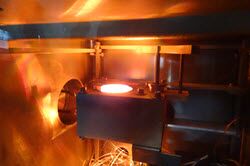A window of opportunity for CO2 reduction
Most people now agree that human activities make a significant contribution to global climate change. The energy consumption and loss associated with buildings play an important role in greenhouse gas emissions, and windows are a prime culprit. With this in mind, scientists are developing better windows in the EU-funded WINSMART project. For the first time, photochromic windows – with a photoactive multilayered structure deposited on a single glass pane – have been developed. ‘We discovered that an important reduction in the carbon footprint is possible through a better choice of materials,’ explains Dr. Niels Morsing, the project’s coordinator from the Danish Technological Institute. ‘We’re able to bring windows’ U-values closer to those of the rest of the building envelope.This means that windows may no longer be the weak point in the building envelope.’ Indeed, windows typically fare poorly compared to the rest of a building’s exterior when it comes to insulating, as indicated by higher U-values meaning higher heat transmission. The WINSMART concept combines vacuum insulation glazing (VIG) with optical transmission control schemes to lower U-values by more than 60 %. Vacuum insulation glazing and the quest for lower U-values VIG is a relatively new concept building on the original double-pane glass one. The space between the panes is evacuated to less than a millionth of atmospheric pressure, with the vacuum preventing almost all convective or conductive heat exchange between the panes. The project aims to reduce the window’s U-value to as low as 0.3 W/(m2·K). Currently available products do not even approach these values due to technical limitations. The U-value of a state-of-the-art triple glazing unit, for example, is at best around 0.7 W/(m2·K). This is significantly higher than that of a well-insulated wall, which may have a U-value as low as 0.15 W/(m2·K). In the first period, the team validated the manufacturing techniques necessary to produce the VIG. Every aspect matters Scientists are also targeting the embodied energy of the frames, as well as the total energy consumption of all processes from acquiring raw materials to recycling and disposal. They aim to reduce the weight of the window by 50%. The environmental impact of the window is evaluated over the full life cycle of the product through life-cycle analysis. In advance of a detailed life-cycle assessment (LCA), researchers defined the LCA methodology and prepared a draft LCA inventory of the proposed window system. Smarter windows save energy Smart windows can also play a role in reducing energy consumption by, for example, optimising the amount of solar radiation that passes through a window. WINSMART researchers are exploring how optical transmission control technologies incorporated into the VIG can facilitate colour change (shading) in response to the intensity of incident light (photochromic) or a small applied voltage (electrochromic). An electrochromic window with a redox electrolyte is being developed as an alternative and improvement upon the current industry standard. ‘At this point in time, the smart technology is one of the most promising technologies being developed. It could be used for new and high-performance buildings,’ says Dr. Morsing. The first window prototype should be ready for testing in the second quarter of 2016. Ultimately, given windows’ contribution to energy loss in the building envelope, widespread adoption of the new technology could have a tremendous impact on the energy efficiency of buildings as well as their impact on climate change.
Keywords
CO2, smart window, energy efficiency, heat loss, WINSMART, insulation, carbon footprint, high-performance buildings,

